Everything seems to congeal, grow leaden, and gum up. It’s sinister in a way, the heaviness that settles over everything. It nurtures a terrifying feeling of suffocation and collapse. If the sky were ever to truly fall, one could easily imagine it occurring in the stale, breezeless hours of a humid afternoon.
However, those stolid afternoon hours had long since passed with the sky intact. The sun had set. Midnight had come and gone. And still, even in the predawn darkness, the humidity remained as thick and sticky as pine resin.
And it had effectively ground Ryan Steiner to a painful halt.
He had known for hours that he wasn’t adequately hydrating. He’d tried to be more mindful, ramping up his intake as the night wore on, but it was too little too late. The humidity had overwhelmed him. Cramps were knotting up his calves. Each breath felt drawn through a wet, warm cloth. And he was tired. He had been on the move for ten hours. Yet, despite all that, it wasn’t until his quads locked up that he truly felt he might not finish.
Ryan draped himself over the back of the chariot. He stared down at the crushed limestone trail beneath his feet. It glowed like faded amber in his headlamp. On his left, the staid black water of the Hennepin Canal ran smooth and silent. A few miles ahead in the darkness, dangling like an invisible carrot, was the small, sleepy town of Colona and the finish line.
“I didn’t think I could make it,” Ryan said, recounting his experience months later. “But I knew that no matter how bad it hurt me, she needed to cross that finish line.” The she Ryan was referring to is Kala, his six-year-old daughter. Kala has cerebral palsy and utilizes a chariot to join Ryan on runs. They trained together for three years in lead-up to the Hennepin 50k. Held annually, during the first weekend in October, the Hennepin Trail Races have become one of Illinois’ most popular ultra-events. They had fought to be there, and it was as much Kala’s race as it was Ryan’s. She had earned this. She had trained and wanted to finish as badly as he did.
Bent over the handlebar of Kala’s chariot, sweat pouring from his roughly bearded face, Ryan knew he had to gather himself. Pain was nothing new to him. Pain he could handle. Ryan had pushed Kala nearly thirty miles, almost entirely at night, in humidity that never dipped below 90 percent. He had to dig in and find a way to gut it out.
“I couldn’t keep her from finishing,” Ryan said. There were no other options.
He had to keep pushing.
* * *

He speaks plainly about it; after all, it is an undeniable facet of who he is. He never belabors having a diagnosis. He never sidles into melodrama. He simply contextualizes it—choosing to see his autism as a catalyst for self-reflection and personal growth. “I have endured a lot,” said Ryan, reflecting on his life. “I went to live in an institution in fifth grade. I am what’s called an ‘eloper.’ When things got rough, I would run. It didn’t matter where I was. I would get upset and take off running. I’d be gone and no one could find me. When they did find me there would be lots of violence and wrestling. It was really hard. I never felt like anyone understood me. Everything I said was misunderstood or misinterpreted.”
At 18, Ryan left the institution and eventually enrolled in college to study autism. While studying, Ryan began to identify attributes of his behavior that informed his impulsion to act in certain ways. Recognizing his own feelings of internalized aggression as a specific autism sub-type, Ryan began to search for proprioceptive activities to off-set his aggression. “I started skateboarding and bicycling. It wasn’t quite what I needed, but I could feel myself getting close. I used to imagine myself running. I knew runners. I wanted to do that, but I was so heavy.”
Weight had always been an issue for Ryan. Prescription medications combined his with tendency to self-medicate through food, had left him severely overweight. “At my heaviest, I was 713 pounds,” said Ryan. He would eventually lose well over 400 pounds, but not before certain people had entered his life.
He met Amanda at bar while she was in town visiting friends and eventually they began dating. Amanda was a runner, and it was her patient approach to the sport and to Ryan that nurtured his earliest running experiences. “She told me, “You just need to slow down, you’re going out too fast.” But I was like, “That’s running!” And she said, “No, no. You’ve got to start out slow. Follow me.’” So, Ryan did. On one of their earliest dates, they ran two miles. “The way that she slowed down was enough for me to catch my breath, but I still thought I was dying,” said Ryan. “It was amazing. Afterwards, I felt that that was exactly what I had been looking for.”
In time they married and Amanda became pregnant. Kala was born seventeen weeks premature. Weighing under two pounds and suffering a severe brain bleed, her prognosis was grim. Her internal organs were shutting down. She couldn’t breathe without a ventilator. Cortical visual impairment had resulted from neurological damage, leaving her blind. Doctors gave her a 2% chance for survival. Kala wavered on the brink for months. Without knowing the extent of damage to her body and brain, Ryan and Amanda began preparing for life outside the hospital. Amanda is a music therapist for people with disabilities. Her experiences, combined with Ryan’s, gave the couple a unique advantage in developing a treatment path for Kala. Once at home, she thrived. Amanda and Ryan worked tirelessly to stimulate her neurological development to such an extent that the vision center in Kala’s brain healed and she is no longer legally blind. Her cerebral palsy has limited her mobility; however, she uses a wheelchair and is learning to walk.
Incidentally, it was a shared desire for stimulation that led to Ryan and Kala’s running partnership. “I need a physical outlet to feel okay,” said Ryan. “I used to just bounce on an aerobics ball, but then Kala thought that movement was awesome. She wanted me to hold her while I bounced, but that didn’t give me what I needed. So, I decided I am just going to go back to running and I am going to take her with me.” Ryan recalls the feeling of that first run vividly. “I knew the moment we stepped out the door and started walking that my goal was to run 100 miles,” said Ryan. “I started this adventure with Kala with the intention of running an ultra-marathon.”
* * *
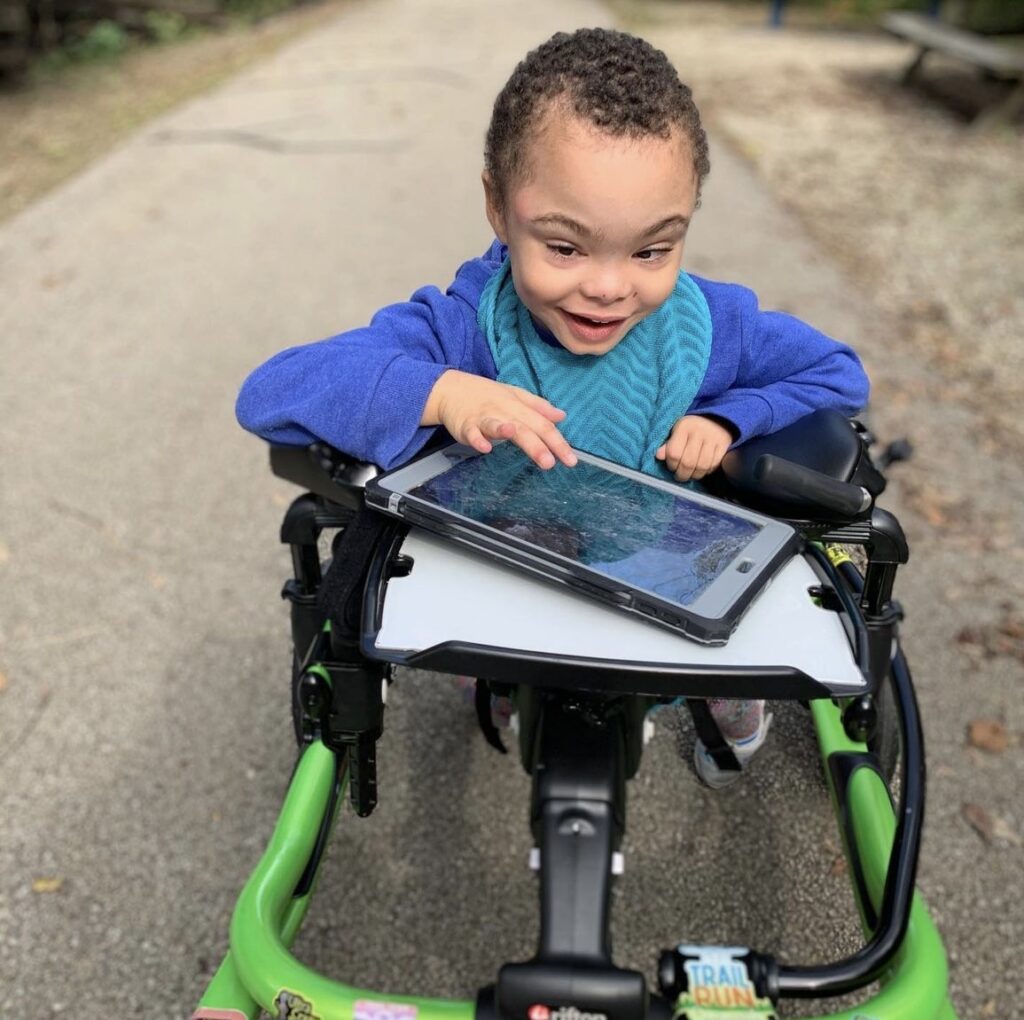
In December 2020, on the urging of a friend, Ryan started sharing their journey on Instagram. In under two months, @running_with_kala amassed over 2,000 followers. He began engaging with people through social media, appearing on podcasts and writing articles. People found inspiration in their story. Ryan went from being misunderstood and misinterpreted, to being appreciated for his thoughtful, articulate advocacy. His decision to be accessible, to tell his story—and his daughter’s story—with an unvarnished realism, resonated deeply with people. His vulnerability before perfect strangers led to his having a community behind him, to having cheerleaders, a genuine support network, and a platform. People listen because his message is essential and nourishing, but they also listen because he knows how to frame it.
* * *
Ryan stopped short of the finish line, took a breath, and briefly surveyed the final hundred feet.
It lay open beneath muted halos of generator lighting, a large white tent flanking the trail. Sponsorship banners were securely cinched to unfurled rolls of blue plastic fencing. Thin, fiberglass poles shot skyward above the fence line, each one adorned with a limp, lifeless flag—perfectly unfettered in the thick, breezeless humidity. Christmas lights twinkled demurely between the poles. Aluminum scaffolding wrapped in black cloth framed the finish. They made it. Ryan lifted Kala from her chariot and placed her in a gait trainer with her bib number securely attached.
Kala would walk from here.
A tremor rippled through the shadows. Those who had been mulling about, or were otherwise occupied, stopped to watch. Many took out their phones and began taking video. What the videos captured is a little girl dressed almost entirely in pink, walking beside her proud father toward two blue timing mats. Murmurs in the crowd became cheers which then became steady applause. Ryan, smiling widely, encouraged Kala forward. “Come on, baby bear,” he said. “Come on.” At the last possible moment, Ryan hung back just enough to let Kala go ahead and finish before him. It’s a subtle, yet rich, gesture—an act of love, humility, and grace. “I could barely move, but I reached down and picked her up from her gait trainer,” said Ryan. “She put her cheek against mine and we just squeezed each other.”
* * *
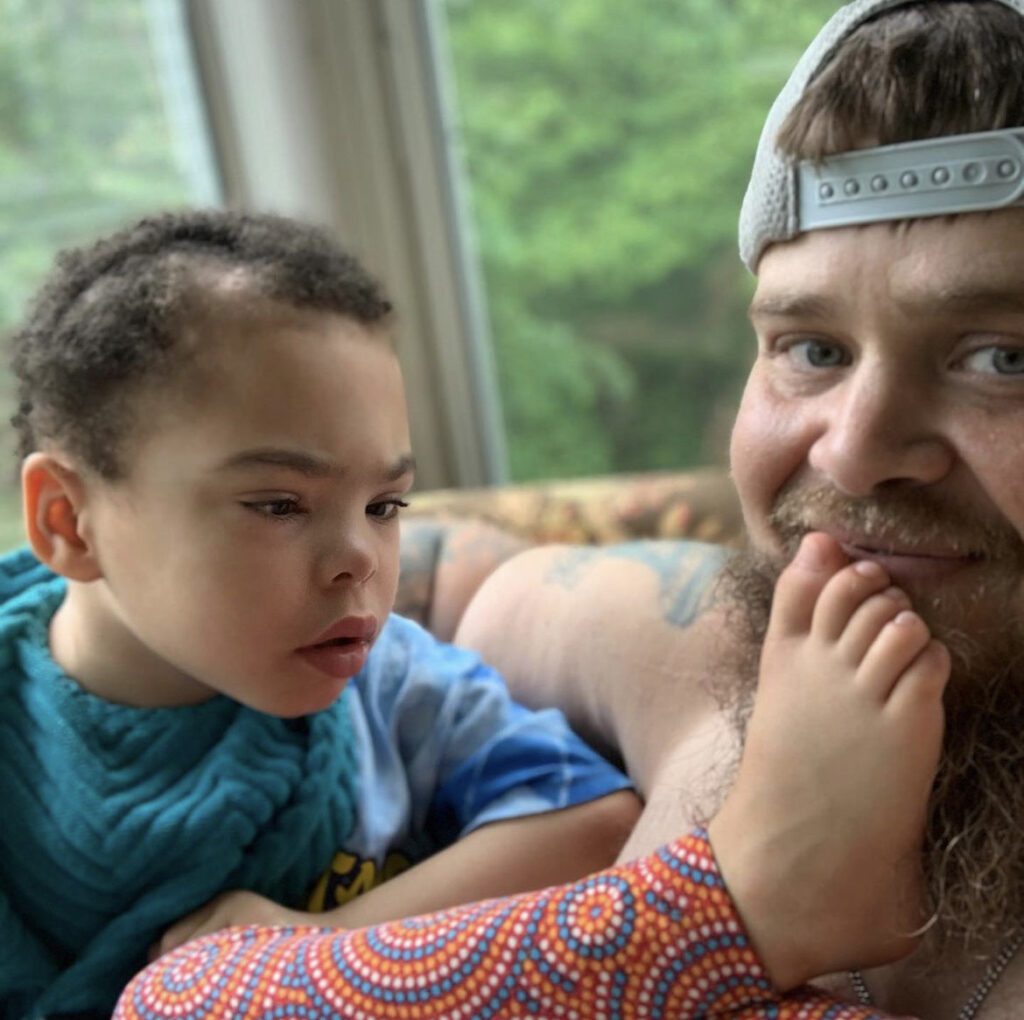
The upcoming year will likely see Ryan and Kala returning to Hennepin. “I will not miss it. That will be our family race every year,” said Ryan. He also plans on running the Earth Day Trail Races, Galena Sky Races, and a fun-run at Kettle Moraine. Each of those events are coordinated by Ornery Mule Racing, which hosts a wide variety of trail events throughout the Midwest. Ryan and Kala have found a home within the Ornery Mule community. “I find a place I am comfortable with, and I stick with that. I branch out with people I am comfortable with and who will branch out with me. That’s an accommodation I make for myself as an autistic person.” Kala will not join him for all of those races. The difficult terrain and changes in elevation on some of those courses make pushing a chariot impossible. Their goal, however, remains unchanged. Someday, Ryan and Kala will attempt to finish 100 miles together.
And, in the end, whether they succeed or otherwise, may not be the point. Perhaps the arc of their story is their story.
Ryan and Kala endure.
Running With Kala originally appeared in Eat Clean, Run Dirty Magazine - Volume 6.
Banner photo provided by Jenny ThorsenOther photos provided by Ryan Steiner
Photos by Tim Roberts
James Solomon pulls into a small, crushed gravel parking area and hooks a gentle left, sweeping his headlights across a sprawling electrical substation set back in the shadows, before coming to stop. Shifting into park, he kills the engine and peers through the windshield at the ambient red sheen of a traffic light bleeding out over Winfield Road. He sits for a moment, long enough for the clear night sky to define itself beyond the glass. The darkness here is near complete. Minor stars glimmer faintly to the east, speckled just above a distant line of black trees, barely visible like subtle variations in a shadow.
Stepping out of the car, James checks his Garmin. From here, he’ll run a mile into the park to Mt. Hoy, where his training will begin in earnest with hill repeats. This is what you do when you’re chasing a record—even when that record is one you already own—you get up before dawn and run.
Ready, James starts his watch and runs into the darkness.
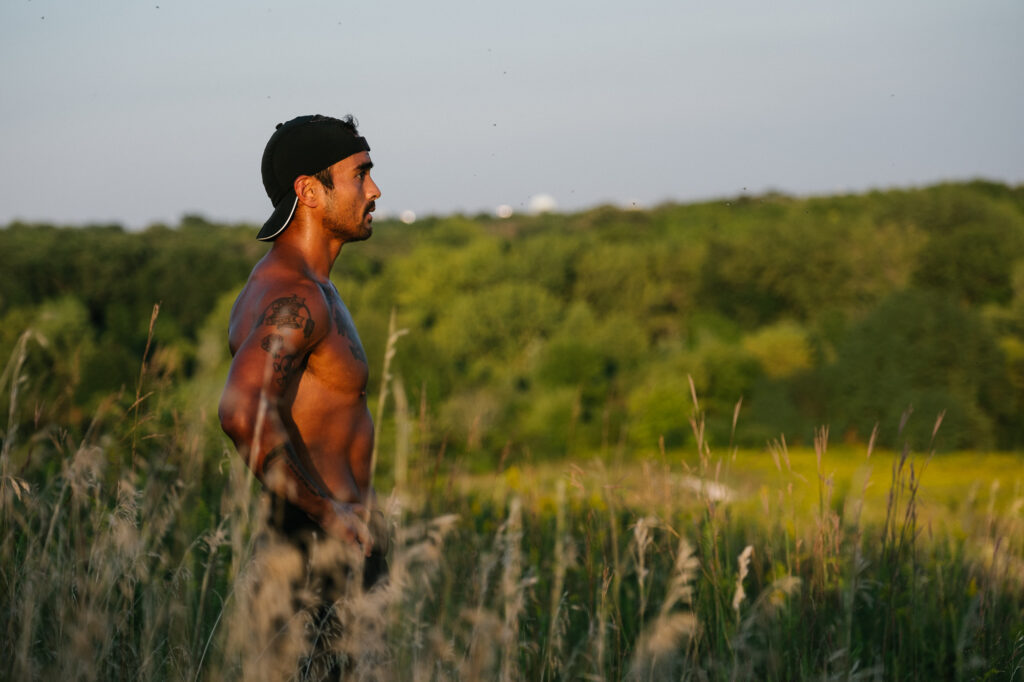
* * *
Hard Prairie: What time do you wake up every morning?
James Solomon: I usually get up around 2:30 a.m. and start running around 3:30 a.m. or 4 a.m.
HP: Do you stretch?
James: No. I’ll do a little percussion therapy with a Theragun and wrap some Voodoo Floss on my ankles and calves, but no stretching.
HP: And you usually run ten miles in the morning, is that right?
James: At least, yeah.
HP: And your nights end pretty early, like 6 or 7 o’clock?
James: Yeah, that’s correct.
HP: But you also run during your lunch hour, right?
James: That’s correct. That’s like my speed work. By the time lunch comes, my legs are warmed up. I can reach a faster pace sooner than in the morning. Plus, all my morning workout are fasted.
HP: So you don’t eat in the morning or drink coffee?
James: No.
HP: You don’t use any caffeine?
James: No.
HP: Are you vegan or vegetarian?
James: I would say I’m vegan. I’ll celebrate with pizza that has real cheese; however, the majority of my lifestyle is vegan.
HP: So you don’t consume much sugar either?
James: Not really. For breakfast sometimes I’ll have oatmeal with blue agave in it. And I don’t skimp on the agave.
HP: And, after work, you don’t ever run?
James: Not typically, no.
* * *

Uncomfortable, but not insufferable. Not wanting to draw attention from park rangers or passing cops, James forgoes a headlamp, choosing instead to run by sense memory and instinct. Beneath him, the path unfurls like a slender tributary of pale, lusterless mercury—the crushed gravel glowing a muted silver in the dark. Off to his right, moonlight dapples the glassy surface of a lake. Along the shore, bullfrogs bellow over the chirp of katydids and June bugs. Somewhere in the underbrush a twigs snaps and a small mammal panics through the thicket.
James never breaks stride.
Last year’s Cry Me A River (CMAR ) plays on a loop in his head. He won the Peoria-based 100-mile ultra and set a new course record; however, as he runs now, he mulls over every remembered detail. He looks for lost time in the flats and downhills and questions whether he loitered too long in Green Valley and Camp Wokanda. He envisions each climb, parsing out which hills might be feasible to run, knowing that if he plans on breaking his own record this year, running up them will be imperative.
Conquering vert is the key to conquering CMAR.
And conquering CMAR, as James knows all too well, is a big fucking deal.
* * *
Hard Prairie: At what point did you decide you wanted to go back to CMAR?
James Solomon: I really got a lot a confidence after my Kettle Moraine race this year. Plus, I had put in the training, and I wanted to teach myself that even if it’s the same race, different problems will happen. It will be a totally different experience.
HP: What was it about Kettle that gave you the confidence to come back?
James: I had a solid goal of a sub-twenty-hour finish, and I went about an hour and a half under that. I surprised myself.
HP: Going into Kettle, what was your training like?
James: I wrapped up Potawatomi in April and did my week of recovery. It was just starting to get really nice out. I was beginning to do a lot more longs runs and hills at Mt. Hoy. I usually use May as a big training month for June and July races. I put in a four-hundred-mile month in May to train up for Kettle and CMAR.
HP: When do you get it in your mind that you’re going to try and break your own CMAR record?
James: Probably my second week back into training. I took a recovery week. Then my first week back, I’m running a lot of flat stuff—but still high mileage. That second week back, I felt better than anticipated. So I began thinking about my goals for going into CMAR, and breaking my own record became my A goal.
* * *
Mt. Hoy wasn’t gouged out by glaciers or exposed through erosion, nor was it born of any grand tectonic event. In fact, it isn’t natural in any geomorphic sense at all. What it is, is a capped mountain of trash. From 1965 to 1973, this property served as the county landfill. Now it operates as Blackwell Forest Preserve, with Mt. Hoy as its most prominent feature—a seven-hundred-foot col, with a one-hundred-and-forty-foot prominence pitched at varying grades depending on which way you go up.
Coming upon Mt. Hoy’s southern base, James glances at his Garmin. He has eight miles of hill repeats ahead of him—no dogging it and no cutting corners. That shit isn’t in his blood. Veering onto the trail, he knows exactly how far he’s come and, just as importantly, exactly how far he wants to go.
* * *
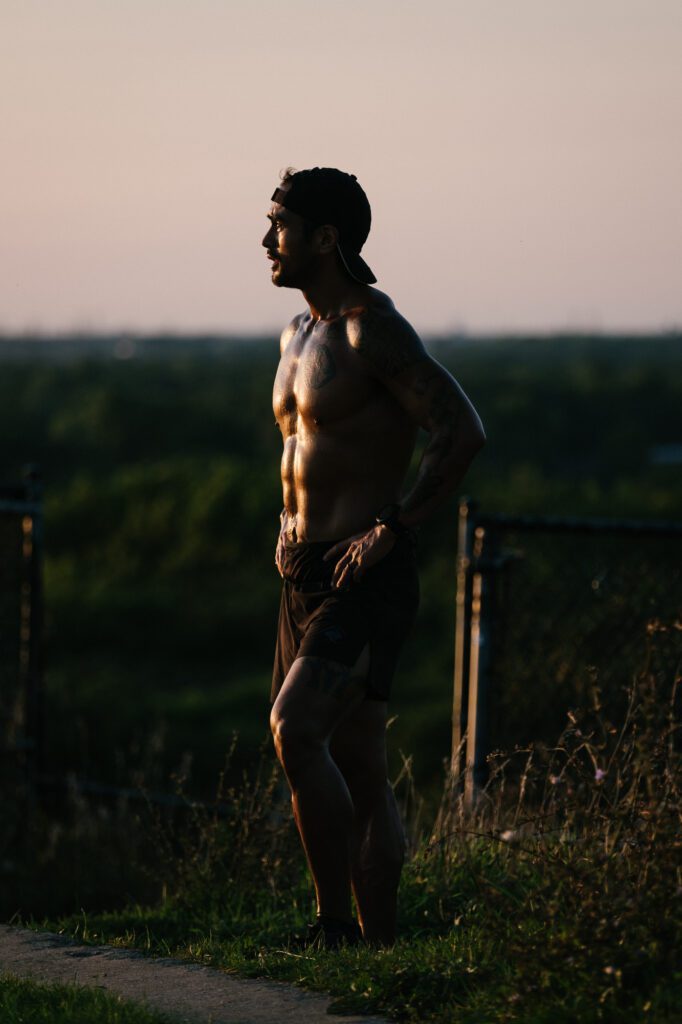
Hard Prairie: What does your hill training entail?
James Solomon: Blackwell opens the gates an hour after sunrise, so I have to run into the park. I park off Winfield Rd and Butterfield. From there to the bottom of the hill is one mile. I’ll get eight miles of repeat in, then I’ll run back. I run up the steep dirt trail on the back of the hill, go halfway down a gravel path, then cut back down towards the road again. And I just repeat that, running it all without stopping.
HP: Is the majority of your hill workout done at Hoy?
James: Yeah, probably 95%. I’ll also go to Crystal Lake at Veteran Acres. They don’t have a single hill like Mt. Hoy, but it’s pretty hilly for a normal run.
HP: In a given week, as you’re building up to CMAR, what is your average mileage?
James: Between 95 and 100-plus miles.
HP: How much of that is hills?
James: Probably 20-30%.
* * *
It drips onto his calves from the saturated bill of his backwards cap. It pools in the groove between his clavicles. Every inhalation detonates in his lungs like an errant bottle rocket, the humidity wreaking havoc with his breathing. He works the hill like a machine, gutting out the miles and logging ascent after ascent. CMAR eats alive the underprepared.
James is determined to be ready.
To the east the darkness shows signs of breaking as wispy grey tendrils of light slip parallel to the horizon. Some mornings, when a run is going particularly well, there’s no notice of the gathering light. It’s just suddenly there, his sense of time all jumbled and askew.
This is not one of those mornings.
Hill days rarely are.
* * *
Hard Prairie: So, you break your own record at CMAR in July. What’s going through your mind when you cross the finish line?
James Solomon: I was super happy. But, really, I was thinking, “Fuck, yeah! This is just one step closer to a top-ten finish at Western States.” That was my honest thought. I got to pace and spectate at Western States earlier this year. I saw all these amazing runners, and I was thinking, “Why couldn’t I be Top-Ten?” So I’m going to put in the work and do the best I can. If I make, I make it. If I don’t, at least I know I put in 100% effort.
* * *
Chest heaving, he places his hands on his waist. Daybreak reflects off the smooth white bulbs of scattered water towers and the windows of office buildings. In all directions, the suburbs spread out like a bland network of rooftops and chimneys and trees. It all looks so still, so sleepy.
James, however, is wide awake.
Hill repeats are a grind—monotonous and painful. But James knows that the grind is what hardens you. It chisels away doubt and fear, clearing a path to accomplishing amazing things on a course as brutal as CMAR.
The grind is how myths are made and how records are broken.

By Morgan Mader
Photos by Tim Roberts
I’m wrapping up my first loop of 2022’s Cry Me A River (CMAR) when a runner passes me. “They’re rerouting us to avoid the creek crossing,” he says. “Another runner got washed away, so be careful.” Had I heard him correctly? I hadn’t been running long enough to begin hallucinating, right? The creek crossing was little more than a rock-skip across. How could this be happening?
“Yeah, James got washed away,” he says. I laugh. James is one of the strongest people I know. He’ll be fine. Still, this is CMAR: a race fully capable of crushing your spirit by methodically grinding away at your tenacity and will. Last year, I trudged through 100K of body-crushing hills in unrelenting rain, developing a chafe that would make most people blush.
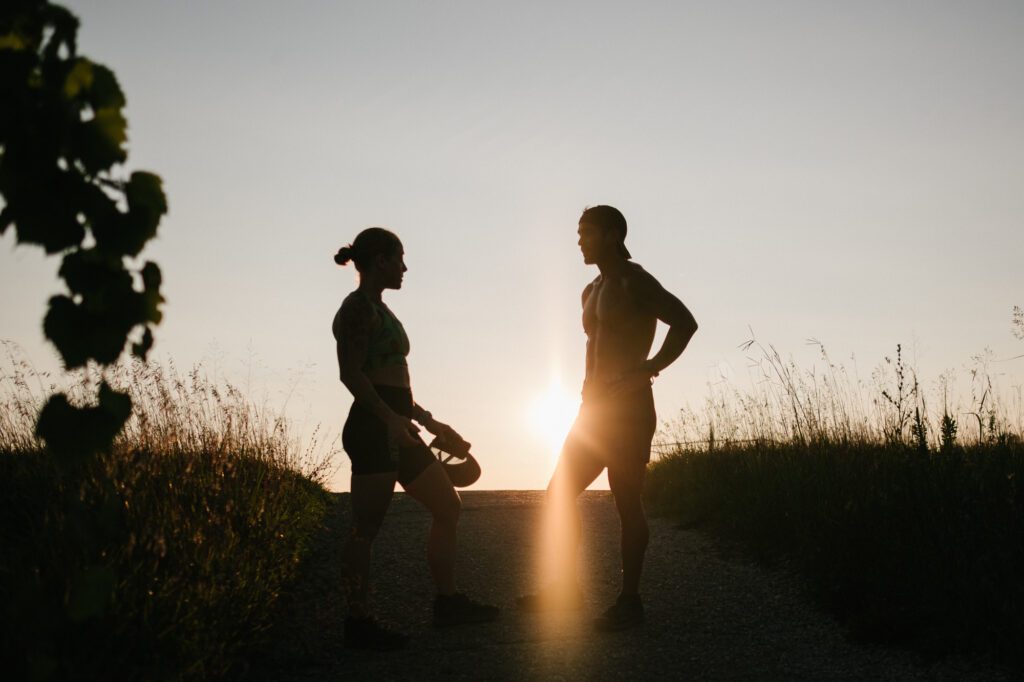
Yet here I was. Back, not for the 100k, but the 100-miler.
CMAR is a brutal course, boasting 23,500 feet of elevation gain over 100 miles. Held each July in the rolling hills north of Peoria, nowhere else in Illinois can you find a race quite like this. Maybe it’s a sickness, craving torture in the guise of fitness, mental toughness and spirit. Though, as the saying goes: If you can do it, then you must do it.
With a noon start, the air was hot and humid. We found ourselves fully saturated in sweat after only 2 miles, and when the rain came, it was a welcome treat. At times, the downpour was so heavy, I was able to open my handheld and catch enough rainfall to enjoy a drink. But as the rain intensified and word spread of the rising creek, my thoughts turned to James. Not because I feared he’d be washed away, but because I knew exactly what was riding on his performance.
The year before, in July 2021, James won the CMAR 100, finishing eight hours ahead of the next competitor, setting a new course record, and doing what many had thought impossible—finishing CMAR in less than 24 hours. When I left out for my final loop of the 100k that year, I knew James was running well. A mile in, I saw his all-too-familiar gait running toward me. We stopped long enough for a brief kiss. I congratulated him and watched him run off to claim victory.
I still had nineteen miles left to go.

After years of weight training, powerlifting, and CrossFit, James decided to sign up for Spartan’s Ultra OCR in 2019, a 50k trail race with over sixty obstacles. Competing in the Open Category, James won, finishing in just over seven hours. Not long after he came to me with a new challenge in mind: Ultrarunning.
I had run a half-marathon before, but that was fifteen years ago. Still, I love nature and stretching my physical abilities, so the transition made sense for me. Once James began researching Illinois’ local races, it was all he could think about. He wouldn’t talk about anything else. He became obsessed, increasing his mileage exponentially. On weekends, he began tackling runs that were thirty, forty, or fifty miles long. The uptick in mileage was not without challenges, however. James learned through unfiltered, raw experience what it takes to ride the sport’s highs and lows. Occasionally, I would field phone calls from the trail when James needed help working through a low. But that’s how we work; those are the things we do for one another.
In September 2019, we ran our first ultra at the inaugural Temptation 200 at Sandridge State Park, near Forest City, Illinois. James’ goal was to finish the 200k; however, after running 100k on the unrelenting sand, he had given all he had and called it. Five weeks later, hungry for a 100-mile finish, we ran Farmdale—a beautiful course that weaves through central Illinois’ Farmdale Reservoir. Seventy miles in, James’ pace had whittled to a walk. He had over-extended himself, going out too fast. Still, he managed to gut out the final thirty miles and earn a buckle. After the race, he was as incapacitated as I have ever seen him. Watching him slowly inch across a McDonald’s parking lot, I questioned whether he’d ever run again. The following morning, I awoke to him standing over me. He was smiling his irresistible smile, asking if I wanted anything from the breakfast buffet. I knew then he wasn’t quitting, not ever.
As 2019 gave way to 2020, James’ resume of ultras continued to expand. With the onset of Covid, running outside became the simplest and safest thing to do to pass the time. Our training runs got longer. We explored more challenging trails and routes. And in September, we were able to return to the Temptation 200. This time James would not be deterred. He won the 200k and established a new course record. This was his first victory, and it was no small feat.
Furthermore, it made James hungrier.

Still, for every success or emotional high, there is heartache and toil. In the spring of 2020, our beloved dog was diagnosed with cancer. Over a period of months, our focus revolved around maintaining her quality of life. She passed soon after the Temptation 200. Heartbreak overwhelmed me. James was equally saddened by our loss, but people cope in different ways. He signed up for Missouri’s Ozark 100, held in mid-November, barely a month later. I was emotionally unavailable to crew him. My absence, and a slew of other unforeseen challenges, ended up derailing his race, and Ozark became his first DNF. However, through this setback we came to understand just how crucial a healthy headspace is during an ultra. More importantly, we recognized how essential our partnership is to our individual performances.
Simply put: We are a team.
Over the years, we have developed a systematic process for how we train, taper, race, and recover. We often run separate events at the same race so that I have an opportunity to crew James once I’ve finished. Spending twelve, twenty-four, or forty-eight hours on a trail will inevitably lead to moments of doubt but knowing that someone is out there waiting to help you—someone who loves you and is rooting for you—can be the difference between a belt buckle and a DNF.
While I, in turn, carry his.
And no rain or raging creek could dampen the truth we carry or keep James from crushing his own CMAR record. This past July, he shaved another hour-and-a-half from 2021’s mark, crossing the line in an astounding 21:39:53, further establishing his dominance over what is arguably Illinois’ most difficult race and positioning himself as one of the state’s toughest competitors.
I’m starting to run out of all wall space here at home, lined as they are with all of our buckles and ornately crafted trophies. Watching James come alive and flourish as an ultrarunner has been a tremendous journey, one made all the more special by the community of supportive, down-to-earth runners, race directors and volunteers that we have met along the way. We have both earned a measure of internal peace from the sport. It nourishes us, in a way. By pushing ourselves and one another, we have each achieved things neither of us ever dreamed possible, and—perhaps more importantly—forged a truly formidable team.
Long literary passages are inked into her arms. There’s a familiar rune and a serpent medallion—the Deathly Hallows, an Auryn; a whole coded language for initiates, for readers—rendered permanently in Ally’s skin. She has no fewer than three tattoos inspired by Kurt Vonnegut, perhaps the most beloved American satirist of the twentieth century. Vonnegut—known for writing ‘Slaughterhouse-Five’ and ‘Cat’s Cradle’ among others—was a humanist. Ally, too, may well be a humanist. Her actions certainly suggest as much.

As founder (Chief Magician!) and Race Director of Chicago’s much-beloved CUSS Running, Ally has given more than $1,000 in race fees to BIPOC and LGBTQ+ athletes over the course of 2022, with hopes to double that sum next year. In July, Ally pledged all the profits from this year’s three remaining CUSS events to the Chicago Abortion Fund and Everytown, a national advocacy organization committed to ending gun violence. “Why wouldn’t I use it (CUSS Running) as a platform to speak up and give back,” says Ally. “CUSS is a passion. It is not my full-time job. It is not my career. I don’t need to make money from this.”
Alongside her wife (and Director of Fast Jogging!), Elaine Young, Ally has built CUSS Running into a dynamic, thriving community. In this interview, she discusses the perks of training in an urban environment, childcare at races, and the difference between inclusion and belonging.
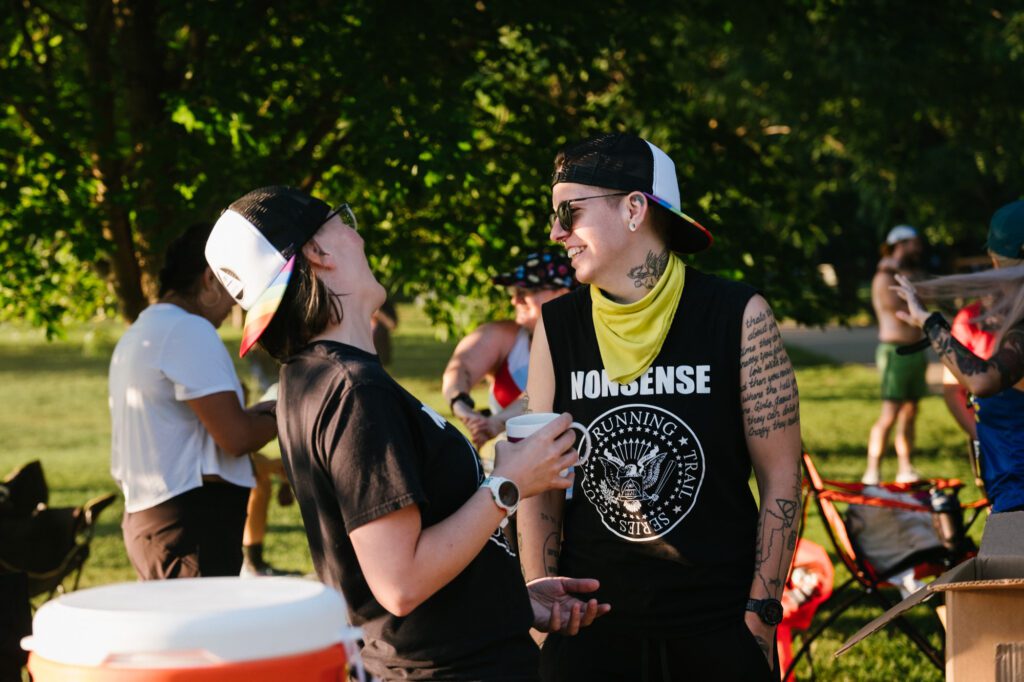
I was seeing events that weren’t the kind of events I would want to attend. So, I figured, let me direct races that I really like. I’m a very silly person. I’m not serious. I’m very introverted. It takes a lot for someone to come to an event and not be intimidated. There are a lot of people who line up at the start and think they’re going to be the last to finish. It was really important to me that people feel happy and have fun. So, I started by putting out funny challenges for people to do. It was the beginning of COVID, before I started race directing. It was dumb shit. But it was dumb shit that I do over the course of my runs because I’m a silly person. And I put it out there because I thought other people would think this is fun. Luckily I’ve been right. I’ve had a lot of people embrace the challenges. There are even people in other countries who do them. So, I started applying them to races. Throughout the course, I have people do challenges and they embrace them.
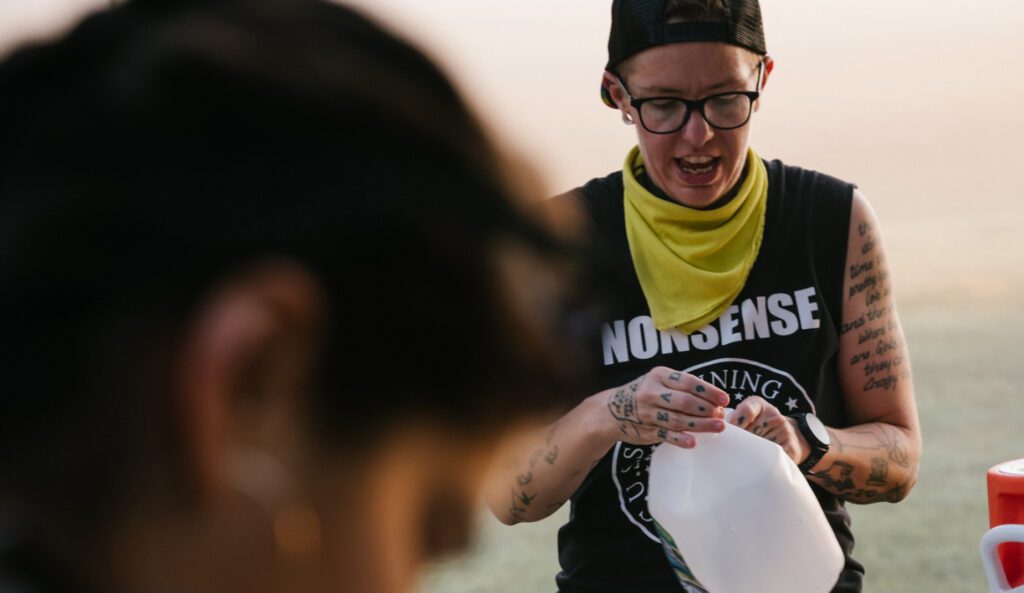
People come to running so excited and so passionate only to quickly burn themselves out. I can’t tell you how many twenty-four- to twenty-eight-year-old men I’ve seen this happen to. And then they don’t run anymore. They leave the community, which is sad. I want everybody to run their whole life. I think if you can find the joy in it, like a little kid running, you can have an amazing relationship with it. You don’t need to do a 100-miler to be an ultra-runner, you don’t even need to run an ultra-distance. If you have it in your heart, and it’s a goal that you believe in, that mentality is what sets you apart. Do you think ultrarunning, as a sport, takes itself too seriously? One hundred percent, for the most part. It’s crazy to me that people are like, “It’s blowing up. It’s getting too big. Why can’t it be like it was before?” Dude, we are the tiniest, littlest niche sport. We are a blip. You need to stop taking it so seriously. It’s still a tiny little community. It has plenty of room for growth before it gets to the level of normal road races.
One hundred percent, for the most part. It’s crazy to me that people are like, “It’s blowing up. It’s getting too big. Why can’t it be like it was before?” Dude, we are the tiniest, littlest niche sport. We are a blip. You need to stop taking it so seriously. It’s still a tiny little community. It has plenty of room for growth before it gets to the level of normal road races.
Oh, totally. I think the thing that makes runners from flat, urbans environments better in a way, is that you have to conquer the mental part without the satisfaction of beautiful views or the diversity of going up or downhill. You have to be mentally disciplined to run distances that are boring. There are people that run thirty miles on the Lakeshore Trail. How wild is that, to run on that path for so long? That would be boring to me. But if people can do that, they can do anything. Also, running in the city, I can stop at a 7-11 or run a route based on bakeries, which I often do. You can’t do that on a trail.
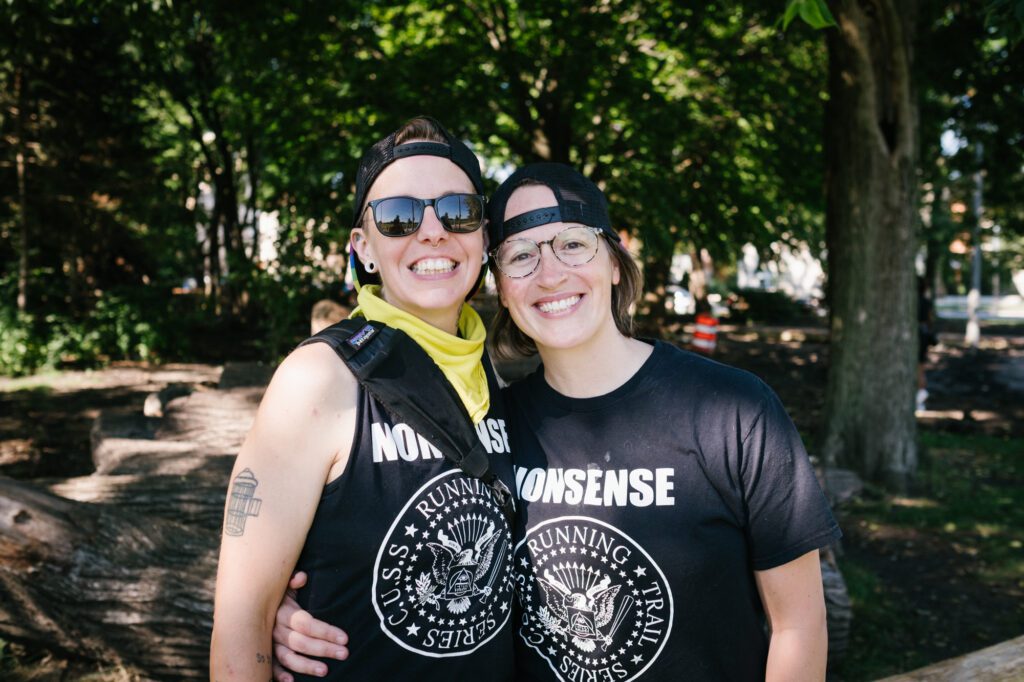
There is a safety issue when training that doesn’t apply to male runners. And they don’t get it either. They think, “Oh, you can get up at four in the morning and run.” No, I can’t. It is a very unsafe environment out there. I think the biggest thing is teaching safety practices at races and teaching women how to be safer by running in groups and facilitating female training camps. That’s huge. They don’t feel safe on trails. They don’t feel safe running early in the morning. And men like to comment on women, which sucks. When they see it happening, I think men should tell other men to shut up. It’s a male problem, but females have to deal with it.
I’ve talked with several people about this and we’re all trying to find a solution. It comes down to taking on a huge liability. So I had this idea: In the same way that I give race entries away, I could create a scholarship fund that goes just to childcare. Like, “Hey, we have money that goes towards a babysitter for the day so you can come out and do this race.” Going through motherhood, being six months postpartum, I thought I’d be more recovered by now, but I’m not. Having education around that would also be beneficial.
I don’t think there’s a lot of diversity among race directors, quite honestly. The vast majority are men. They don’t understand a lot of those challenges as a hetero person. For me, as a queer person, I’ve had it pretty good. I’ve pretty much never been in the closet. But I have so many friends who have been closeted and still carry so much shame around that. So being able to show up to an event as yourself is something unique. If I can be that voice that not only welcomes you but tells you that you belong, that’s a big thing. There’s a difference between inclusion and belonging. Saying that you include someone, that’s something you’ve determined. You control the space. But saying you belong here, is a whole different narrative. I’m not transgender. I had to go talk to transgender runners and ask, “What am I doing here? Am I doing this right?” I give free races to queer and people from marginalized communities across the board. Just email me and I’ll send you the code. I’m not going to ask you for proof. I’ve had people email me who are in the closet, asking if they can still participate in this. I’m like, “Oh, my god. Even more reason.”
If you have an idea and a passion for it, just do it. You’re perfectly capable. There is plenty of room in the trail and ultrarunning space for more races and for female race directors. Don’t let fear hold you back.
Edited for length and clarity.
Beside him, two looming intake towers rose up out of the water like castle turrets. The squat, conical spire on the tower nearest to shore glowed pale green against the opaque morning sky. Some distance away, nearly eye-level with the bridge, an egret glided silently toward a thick stand of elm trees along the far bank. A smattering of small boats drifted at anchor between the hulking concrete pylons below, the faceless men onboard casting lures into the current. To the south, set low against the horizon, the St. Louis skyline spread out dusty and grey in the August heat like a solemn oasis. “It was serene,” says Patrick. “It was a beautiful, breathtaking place, standing over the river.”

With him on the bridge that morning were more than sixty other runners, all having gathered to fundraise on behalf of St. Jude Children’s Research Hospital. Divided into teams, they’d spend the next two days running a relay, traveling more than 176 miles along spalling county routes; running on narrow, brittle shoulders and main streets through small Illinois towns like Bath and Havana, stopping to rest at gas stations and bingo halls, until they reached the Civic Center in downtown Peoria.
He was, after all, lucky to be alive. In December 2020, doctors diagnosed Patrick with liver failure. “That will wake you up quickly,” he says. “Unhealthy habits had developed in my life. I was 300 pounds and drinking more than the average person. I was still responsible—I had a full-time job and kids—but, looking back, it all makes sense. At the time, I just didn’t realize it.” After three days of labs and imaging scans, the doctor’s prognosis was bleak. “I was given a 50% chance that my liver would work again. But if things went wrong, it was a ninety-day mortality rate.”
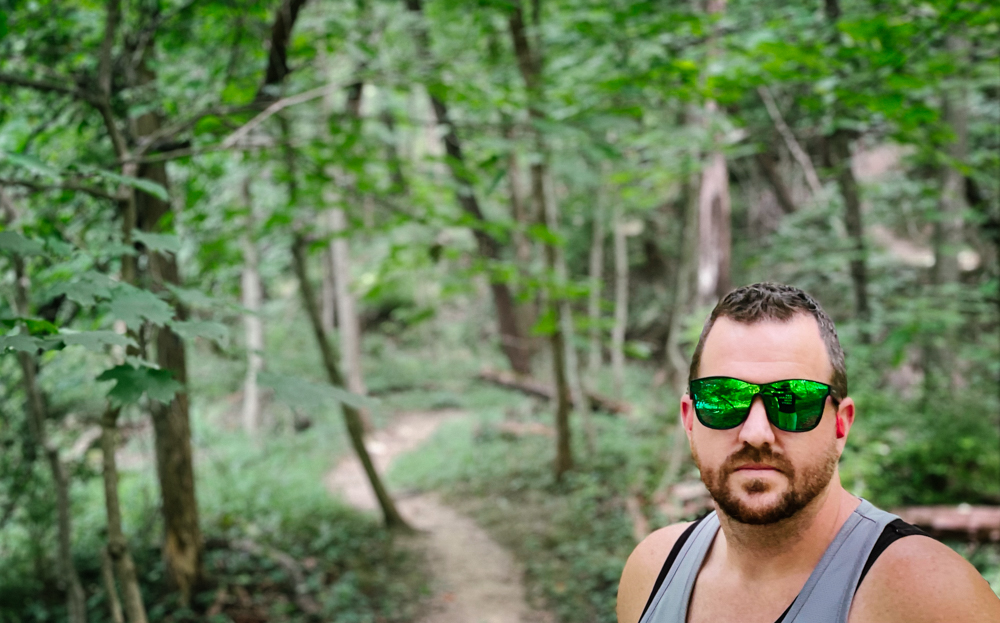
While still admitted in the hospital, he and his wife, Jami, began developing a plan to overhaul their lifestyle. “We very much took this on as a team,” says Patrick. “That’s kind of how we’ve always worked. This is the problem; how do we fix it?” Any dietary changes Patrick would have to endure, so too would Jami. That was the deal. They met with a nutritionist and Jami began exploring recipes that were both sodium and sugar free. She understood that in order for Patrick to stick with a new diet, it was imperative to find things he liked. “I went full force,” says Jami. “I researched healthy eating and smoothies. I joined a Facebook group. I made lemon water to help remove bilirubin from his system. Whatever I could do to get him nutrients, I did. I probably spent 500 hours in the kitchen making sure we had healthy food.”
“Weight was falling off my body,” says Patrick. “I went to the doctor, and they said I needed to start working out. My body needed muscle.” Photos taken of Patrick during this period are difficult for him to look at. “My body was a potato with twigs sticking out of it. I was extremely happy to be alive, but it was frustrating to realize how unfit I was. I’ve never had much interest in working out. I don’t know how to lift. I don’t understand how to build muscle. So, I just decided to eat right and run.”
Patrick had tried running before. Years back, he’d even completed a half marathon. “Unfortunately, when I crossed the finish line, I stopped running and went back to eating junk food,” says Patrick. “I’d met my goal and that was the end of it. But I like the idea of being able to run for a long period of time. It’s hard. Not a lot of people are able to do it. And I wanted to be one of them who are.” Patrick began setting small goals for himself. He liked how a quarter mile could slowly evolve into a mile, then another, and another, without any undue pressure. Slowly, as he began to ratchet up the mileage, he could feel his body beginning to heal and his muscles beginning to tone. “I lost another twenty pounds,” says Patrick. “I’ve kept the weight off. I feel on top of my health and fitness more now than I ever did before all this.”
“The biggest heartbreak I felt throughout all this was my wife telling me that she didn’t want our kids growing up without their dad,” he says. “I always thought that sounded cliché, but it’s cliché for a reason. My kids are absolutely my best friends. They are the coolest people in my life. I am overly proud of them every single day, even when they’re driving me nuts. I can’t imagine not being here for them when they need me. It’s painful to think about. They’re what I look forward to; they’re what drives me.”
Back on the Old Chain of Rocks Bridge, Patrick grew anxious. “I was extremely nervous,” he says. “I had trained really hard for this, and I wanted to run every mile I possibly could.” Just before the relay began, the group listened as a fellow runner spoke of their own experience with St. Jude Children’s Research Hospital. “It was really touching,” says Patrick. “We got to hear how fantastic they had been treated. How insurance isn’t even a question, or, at least, not the first question. All these kids are going through trials most of us will never have to face at a young age. They just want to get the kids in there and taken care of.”
Cutting a jagged course through southwestern Illinois, past large swaths of corn and soybean, thorough unincorporated villages without so much as a church or a bar, on two-lane highways and backroads without markings, past strip malls and small industrial manufacturers, antique shops and fast-food joints, over hills that rose up in isolation, in 80% humidity and an AWOL breeze, Patrick just kept clicking off the miles.
As they entered Manito, a small town twenty-five miles outside Peoria, he felt a rush of familiarity. At one point, Patrick had been a volunteer firefighter in town. In fact, it was how he came to know about the St Jude relay. “The fire department would escort the runners through our district, and they’d stop for lunch at our firehouse,” he says. “I met some of the runners. They were always poking at me to get involved, but I was never healthy enough to do it.”

“The reception we got heading into town—seeing our friends and family, our husbands and wives all cheering us on—it was really special to see everybody come out and support us. On a hundred-degree day, we were greeted with water guns and hoses. It was really cool.”
Reflecting on his experience, what stands out most to Patrick about that weekend is the camaraderie that developed between runners. “The whole experience was reminiscent of summer camp. You go away with all these people you don’t know, and by the end of that couple of days it’s like you have a bunch of new best friends. It’s really a special thing. It’s a bond you share.” And those are the things that matter, the heightened experiences that forever bind you with another person—be it your wife, your child, or a complete stranger. Those are the things you carry with you when things get dark.
When it was all over, Patrick had run more than eighteen miles. A remarkable turnaround given the prognosis he’d received less than two years ago. “I know now that if I keep doing this, I am going to see results,” he says. “I needed to see that. I needed to understand that it’s going to suck while I do it, but, so long as I continue, there’s fruit that will come of it later on.”
“He’s determined,” says Jami. “He loves his kids, and he wants to fight for his kids. The negativity is out. We don’t have time for it anymore. We have time for raising our boys and spending our life doing what we want to do, what we love to do. If your husband had been given a 50/50 chance of living, you would do that too.”
Maybe you mellow it out with cream and sugar. Or maybe for you coffee is an expression of high art, a search for the sublime in a single cup. However you regard coffee, what is indisputable are it’s inexhaustible qualities and seemingly endless variations. If a fresh idea comes along, even its newness feels vaguely familiar, like it already exists, and has existed forever.
When Tom McGinn and Jenni Guerriero began developing what would become the electrolyte-infused Long Run Coffee, they strongly questioned the originality of their idea. “Step one was figuring out if it existed already or if we were wasting our time,” says Tom. They scoured social media and Google, typing untold keywords in myriad variations, but kept coming up empty. “We really tried to find it,” says Tom. But there was simply nothing to find.
“There is no one else selling this,” says Jenni.
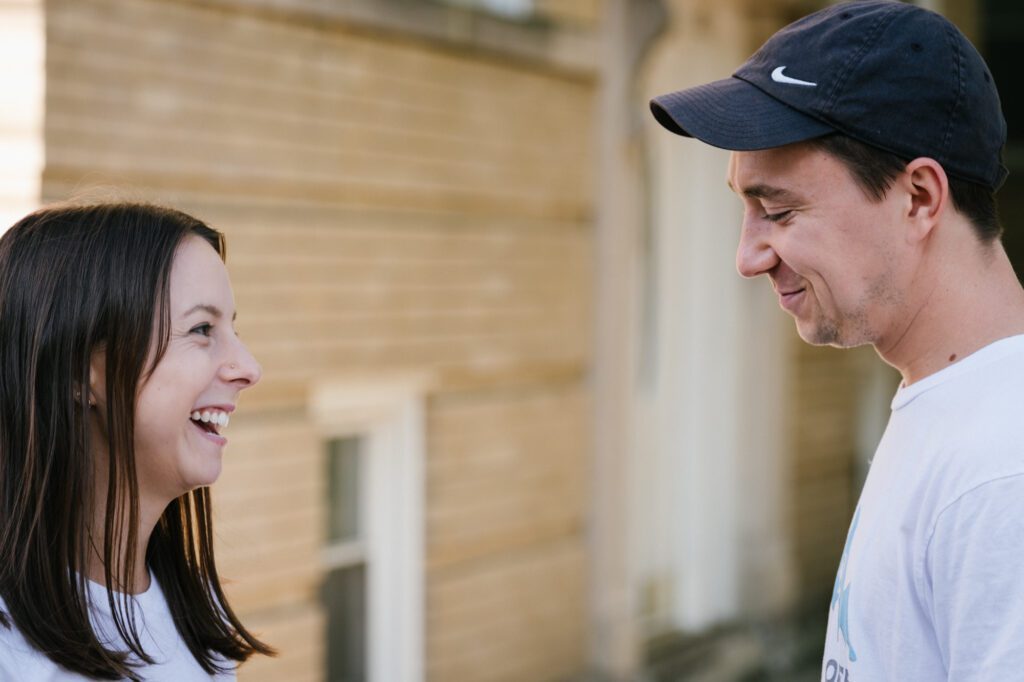
Looking for ways to make a distinct impact in the running community, fortifying coffee with electrolytes seemed both practical and potentially beneficial. Most runners consume caffeine in some measure—either prior to and/or during a race—why not boost it with minerals essential to maintaining performance? It just made sense. So one morning, while cooking breakfast, they finally began toying with the idea. Tom scooped two hefty spoonfuls of pink Himalayan sea salt into his coffee, stirred it, and took a sip. “It was terrible,” he remembers. “It tasted like seawater.”
Still, it was a start.
“We immediately began tinkering with it and testing it,” says Tom. Over a period of months, every trial was recorded—every tweak in the measurements, every powder or granule used, everything on down to taste was logged on an Excel spreadsheet. “Part of the problem we faced was figuring out the actual source of the electrolyte,” says Tom. “The big ones we struggled with were sodium and potassium.” Initially, they experimented with potassium citrate, which tastes nearly indistinguishable from salt and, when paired with certain sources of sodium, has the potential to blow out your palette. “There was so much trial and error,” says Jenni. “We had friends try it and other runners. We kept wondering, ‘Does this taste salty to you?’” Over time, they settled on sodium bicarbonate and potassium gluconate, both of which are easily dissolvable and have a flat, neutral taste that doesn’t interfere with the natural flavor of the coffee.
This, however, proved surprisingly difficult. “We had to go through five or ten different manufacturers, calling their customer service lines and sending emails,” says Tom. “Basically, they all responded with, “No, we’re not doing that.” Some companies said they wouldn’t add electrolytes, but they’d add CBD.” In retrospect, Tom and Jenni may have thrown off manufacturers with their explanation of the product. “If we had just said sodium or salt, instead of electrolyte supplements, maybe we would have gotten more traction,” says Tom. “I think companies got scared even though it’s pretty simple stuff. I don’t think they wanted to put any of it through their machinery. They wouldn’t have, but we didn’t get the chance to explain that to many of them.”
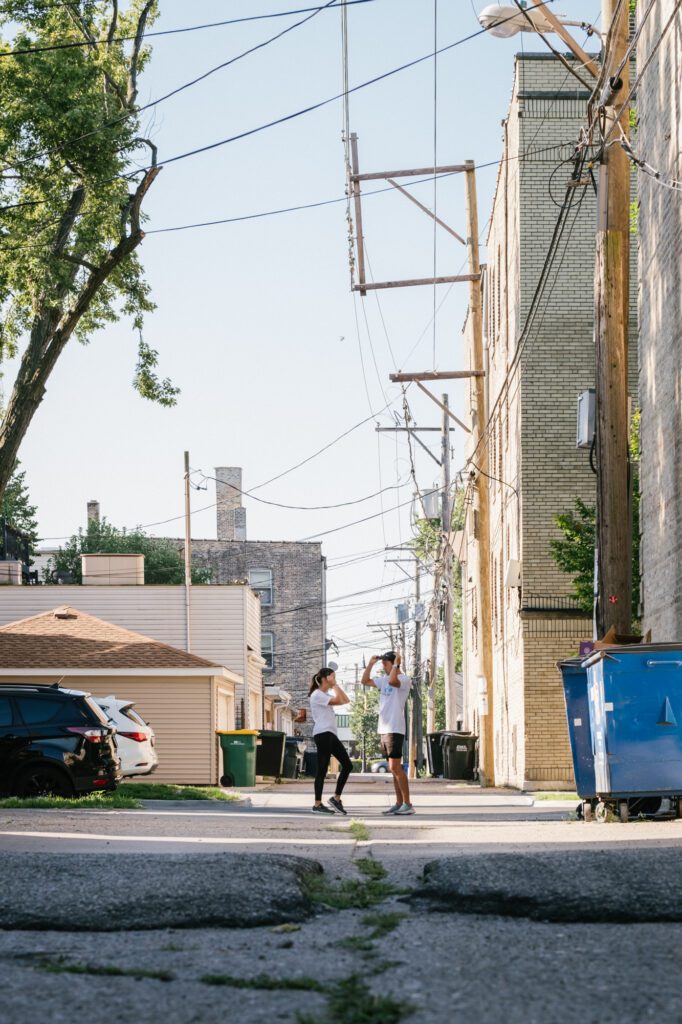
Eventually, they found a roastery in Spring Grove willing to partner with them. “They were like, “We’ll do whatever you want,’” says Tom. “They’re local, basically in our backyard, so it’s good. They aren’t a giant conglomerate. I can basically pick up the phone and call someone whenever.”
Offering four signature roasts, they established footing rather quickly. Among their earliest supporters were the hosts of the popular Ten Junk Miles podcast, who also happen to host events in southern Wisconsin. “We went to Sugar Badger in May and the Badger Trail Races in July,” says Tom. “We had a booth and were handing coffee out to runners. It felt like we were running an aid-station. We enjoyed that.”
As summer progressed, Tom and Jenni continued developing Long Run’s mission and reach. They sought inroads and partnerships, local and otherwise, gauging interest and honing their pitch. “A lot of great communities exist in the running space,” says Tom. “We want to make custom label coffee for different brands and communities that are already out there.” Forging relationships with race directors, neighborhood organizers, and charitable foundations, they created two lines of brand-specific custom coffee—the Race Collection and the Community Collection. In late August, they began offering those collaborations for sale on their website. ”Part of our hope is that people will come to our website and get coffee that means something to them, then see some different brands and races that they haven’t heard of yet,” says Tom. “We would like to create a little network. That might sound ridiculous to build a network on a coffee site, but I don’t think it is.”
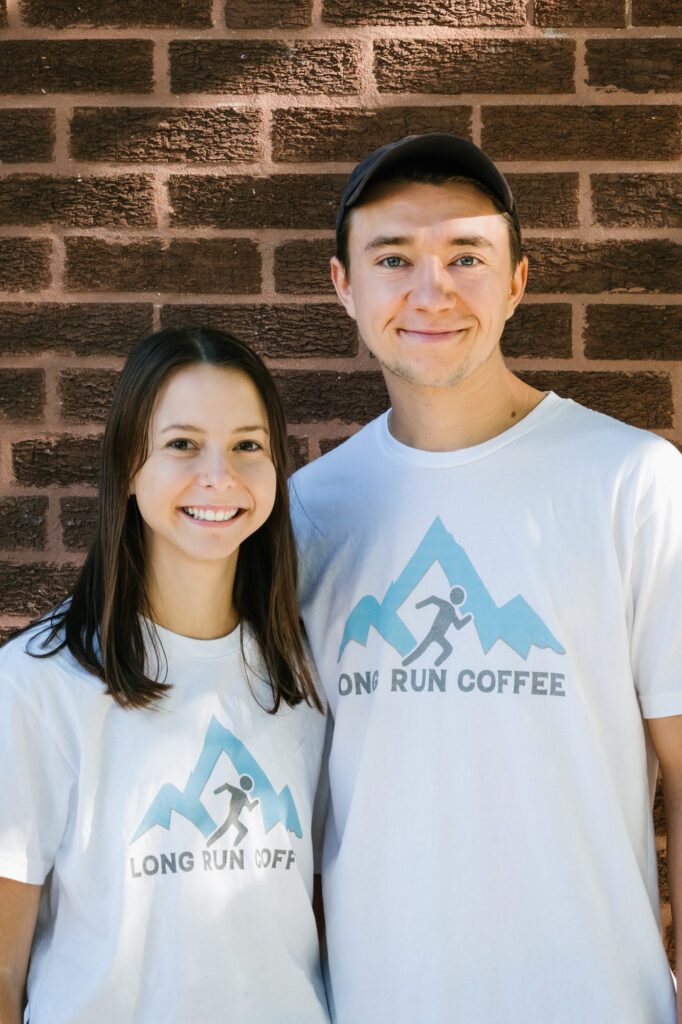
“What happens happens,” says Tom. “Obviously, any opportunities that arise should be looked into; likewise, if things that we put a lot of time into end up not working out, that’s okay too.” Attending this year’s Hennepin 100, they brought with them a new collaboration with event host Ornery Mule Racing. Dubbed the “Flat and Fast French Roast,” Long Run set up shop at the race, offering brewed samples and selling bags of this latest custom label made specifically for the event. “We would like to start going to more races,” says Tom. “Mainly because they’re fun, but it also makes sense from a business development perspective.” Looking to establish a broader race-day impact, Long Run is also looking into developing single-serving coffee packets as a unique twist on the usual assortment of swag bag giveaways. Being that they are still a young company, however, the priority for the foreseeable future is to continue growing while clearly conveying their mission to both the running community and prospective partners. “If a Race Director reaches out to us, we’re making him a label for free,” says Tom. “We don’t need any financial investment whatsoever; we just need their approval. End of story. You don’t need to buy $600 worth of coffee. We’ll just list it on our site and fulfill it all.”
Big picture aside, Tom and Jenni want more than anything for Long Run Coffee to be that extra encouragement that propels you, the athlete, forward. “It could be a daily reminder that you’re signed up for a 100-miler,” says Tom. “Something that will be there in the morning, waiting on the kitchen counter next to the coffee pot.”
It’ll be waiting for you like so many training miles and hill repeats. It’ll be waiting for you like a belt buckle at the finish line.
“It will just be there,” says Tom.
An inexhaustible little bean, perfect for the long run.
Photos by Tim Roberts
“They watched him with something like awe…as though
he’d just returned from a period of wandering in some
remote and holy place, in sand barrens or snowy ranges—
a place where things are said, sights are seen, distances
reached which we in our ordinary toil can only regard with
the mingled reverence and wonder we hold in reserve for
feats of the most sublime and difficult dimensions."
—Don DeLillo, White Noise
Right now, high upon this ridge, we exist only in our lamplights as thin black membranes seizing against the cold red earth. We are like phantoms reveling in their lack of any bones. Things feel fluid and chaotic and not, all at once. Like we’ve given in to an undertow.
I have a lot of raw emotion this morning.
From the valley, we must appear feebly, if at all. Just some faintly shimmering wisps of light patiently ascending in the predawn like bubbles in a boundless inkwell.
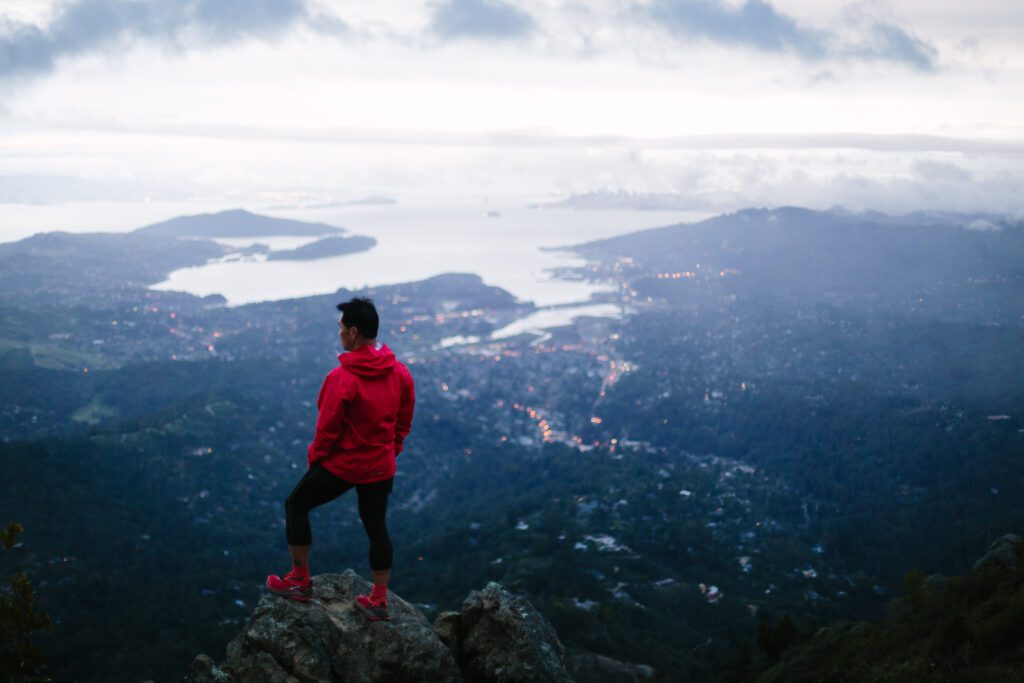
I am feeling very teary and vulnerable.
We are five relative strangers casually talking about light things in the dark, moving like a narrow band of flickering cursors against a flat, black nothing.
God, I wish you could see this.
* * *
Race hardware doesn’t interest him. Neither do Ultrasignup trophies, gender placement, or age rankings. Fuck all that. None of it means anything. None of it has a pulse. None of it bleeds, digs deep, or hallucinates. It’s all just sterile coding, a hollow register of zeroes and ones.
What Michael seeks is only found in the unnerving emotional vacuum of hump miles. “Anytime you push beyond what you have accomplished before,” says Michael, “you are forcing yourself to expand, and there is always an unknown. I hate the unknown. I will do everything in my power to mitigate the unknown.” Yet that’s where all the good shit is, in the vague middle distances.
And Michael knows it.
In March 2021, he completed a self-styled 200-mile fatass on Mount Tamalpais (Mt. Tam), a prominent peak in the Marin Hills north of San Francisco. Running the same eight-mile loop twenty-five times over four-and-a-half days, Michael also bagged 57,000 feet of grueling vert. “You have a different sense of understanding and empathy after you have been through something like that,” says Michael. “It’s an experience that’s hard to explain.”
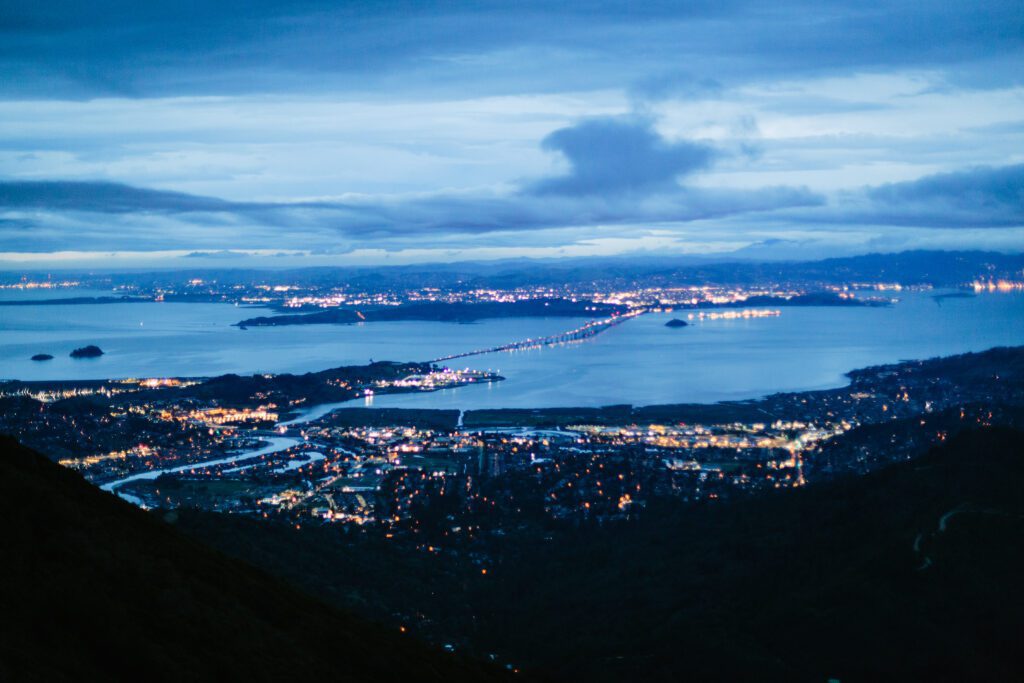
So, late last year, Michael began putting the pieces in place to up the ante. “I wanted to run 300 miles,” he says, “and it had to be 100,000 feet of climb. Those things were not negotiable.” Crunching the numbers, it felt doable. Forty laps. Ten days. Roughly 50k per day, with 10,000 feet of vert. “I can go fast if I want to,” says Michael. “This was about going slow to go far.”
He also gave the fatass a name: The FKTam300.
On the morning of March 17, 2022, standing in the darkness beside a tall, four-sided clock—the marker which would serve as the beginning and end of each lap—in the quiet, sleeping heart of Mill Valley, Michael smiled, snapped a photo, and ran into the unknown.
* * *
“He’s a rare feather,” says Carla Landrum, an ultrarunner and friend to Michael. “If he says he’s going to do something, he’ll do it. Come hell or high water, he’s going to do it.” One would be forgiven for assuming that Carla is referring to Michael’s tenacity. She isn’t, although it certainly applies. Rather, Carla is alluding to depth of character, his unwavering capacity for other people. “There is a social circle where you go and have and few beers and a couple laughs. But the people who will be there when shit gets hard? Michael is there,” says Carla. “There is a fundamental level of trust that I have with him that I don’t have with other people.”
Kendall Young similarly echoes that sentiment.
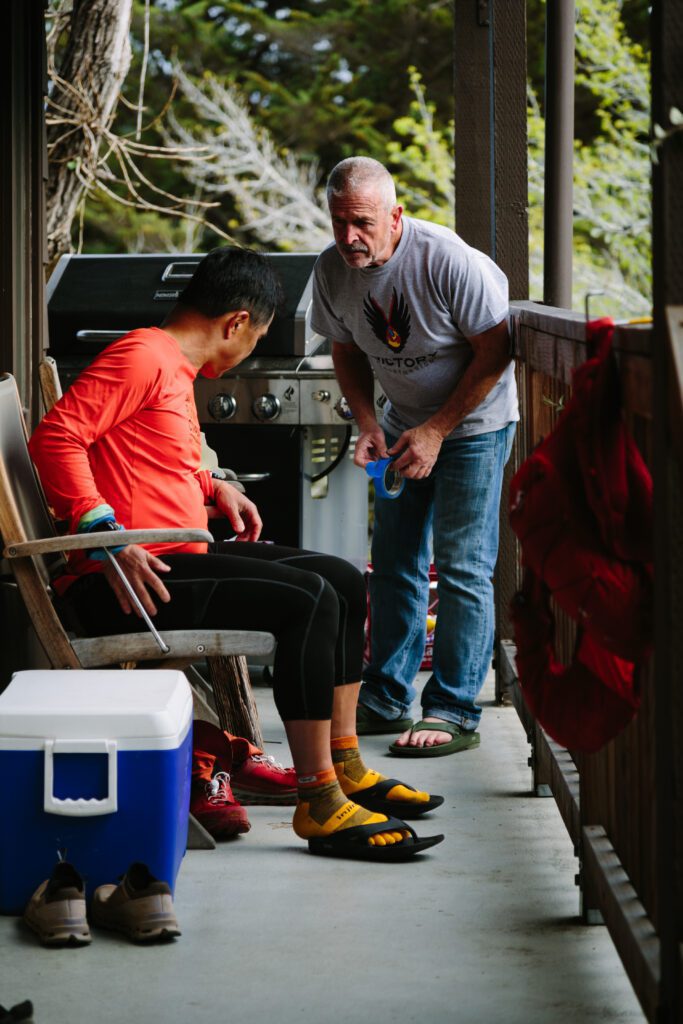
Having known Michael for nearly a decade, Kendall has served as Crew Chief for both Mt. Tam fatasses. “He is willing to go to service for someone in a way that is not very common,” says Kendall. “Which is friggin’ cool.”
When asked why Michael is so adept at navigating difficult challenges, Kendall’s response is customarily California. “There is this thing called the Integrity Tone Scale,” he says. “Without getting too ‘crystals and incense’ about the whole thing, dense vibrations are heavy. Things like sadness, concern, worry, whatever. They are all denser and further down the scale. Being down on the scale isn’t necessarily a bad thing, there is just less freedom to react. Michael will be sliding up and down this tone scale. At 200-miles, he might be feeling like there’s no way out. But here’s my point: He lives higher up on the tone scale than anybody I know. And it’s not just positivity. True freedom is the ability to not have something. This is critical to understanding Michael. He is absolutely willing to have this blow up. He lives in real freedom because he is willing to have it, but also equally willing not to have it.”
“It’s truly trippy.”
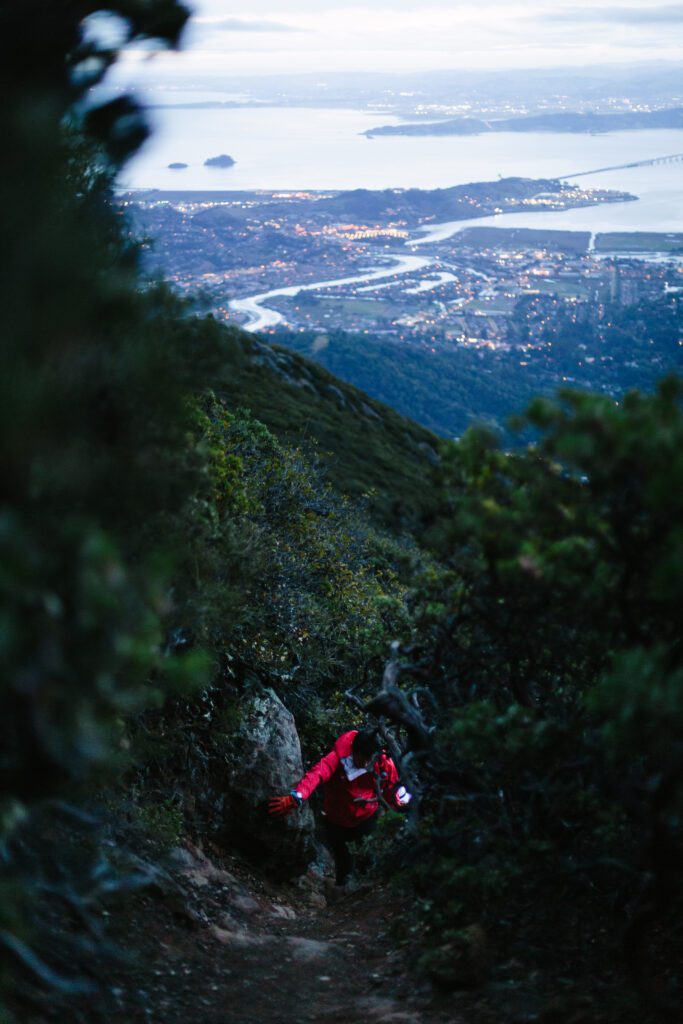
* * *
Through gaps in the coyote brush, the sky gathers form. Deep blue striations of light fan out along a dark furrow of distant hills and bleeds into the bay. Far below, San Francisco sparkles with fading intensity, while a gentle mist, frigid in the half-light, falls sideways and seeps into our clothing.
I am sorry tomorrow is probably going to be rainy.
Michael sets the tempo, leaning hard into a series of long, tight switchbacks. It’s his third day on the mountain. The composite fabric of his red running vest glows in vibrant contrast to the thin white base layer clinging to him like a second skin. On each wrist, he wears a fēnix smartwatch. He moves buoyantly, with childlike playfulness, running like someone who has tapped into a cosmic artery and is drawing energy from an immeasurable source. At fifty-five, he belies his age.
I am still 288 miles from finishing.
Four of us—Isabel, Carla, Tim, and I—fall in single-file behind him. Michael is keeping the mood bright, acting as a tour guide in the lingering darkness. He points out the lights of San Quentin. He points out the lights of Alcatraz. He points out the lights of the Golden Gate and Bay Bridges. He is an affable, dynamic conversationalist, rational and engaging. His vitality is infectious.
I know I am rambling. I hope there is something in these moments that will help you understand.
“Hear that?”, he asks. We stop and listen. A rich vibration reverberates off the steep serpentine wall. It sounds like a massive alien pump organ droning over a nasty swarm of mechanized hornets. It’s a brutal, disparate moan, booming and ancient. When I hear it, something in me splits wide open. It’s like I’m being spoken to in the mother tongue.
Michael smiles boyishly. “That’s the mountain,” he says, and tears off up the slope, leaving us to exchange confused glances.
God, I wish you could see this.
* * *
The mix reeks like cancer. I try not to inhale the fumes, but it’s futile. Acrid plumes of smoke billow from the hopper and foul up my diesel-stained clothing with a fetid, hellish smell. I’ll leave work today stinking like death.
WhatsApp pings my phone. Sprinkling sand over the steaming new patch, I check the notification. It’s a voice memo from Michael. I tap play, tuck the phone into the breast pocket of my work shirt, and continue filling potholes.
“Good morning, buddy. It’s day six.”
I smell sage and eucalyptus.
“I am standing on top of Tam, on loop nineteen.”
I see the fire tower on the summit.
“It took a little digging to get up here. I’m in those hump miles. These miles are always fucking hard.”
I see tiny, forested islands jutting out of the bay like dull incisors. A vibrant sprig of wildflowers. A vulture strafe a canopy of fir trees.
“Norman, one of my crew, is with me. He was positive the whole way, making jokes. I wrote some posts thanking my crew. I couldn’t do this without them.”
I see tumbling scree, slow-moving newts, and a green slug that is six-inches long. I see Michael running on the fire road. Michael at ‘the scramble’. Michael doing yoga. I see Buddha Rock, Angel Island, and the Anti-Tam.
“Shit. It’s getting hot.”
I hear labored breathing and a scraping sound.
“But I am going to get this done.”
I see a sky on fire and glistening black beads.
“I am going to get this done.”
The message ends abruptly.
And I go back to holding my breath.
* * *
“That’s the simple foundation of friendship. Michael is full of love, and he shovels that out to people. He doesn’t even think about it. There is no strategy behind it, that’s just true-blue Michael. And it brings out the best in people.” Michael is a stalwart in the Bay-area ultra-community. If he isn’t donning a bib, he’s clearing trails, pacing friends, haunting finish lines, or RDing events. His omnipresence, paired with his conviviality, has forged meaningful relationships that Michael continuously nurtures with patience and subtlety. He is blessed, in the truest sense, with an unfathomable depth of friendship.
He shows up for people, and they, in turn, show up for him.
Michael has been bringing people to Mt. Tam for years. “It’s like a sacrament,” Kendall says of Michael’s eagerness to share the mountain with others; the sunrise, in particular, being a favored gift to give his friends. “He really is a conduit for many people’s experiences. And he sees himself as just that.”
“When you go on a run with him, it is about you and that moment,” says Carla. “He knows very well that that moment is special, and he does try to capture it with pictures. When I first engaged with that, I was like, “Dude, we are burning so much time. Can we just run? What is with this picture nonsense?” She laughs, then grows very quiet. For a brief moment, there is silence. “Until the end of the year when I had hundreds of pictures on my computer. I went back and looked at those pictures, some of which I completely forgot, and it just hit me hard.”
“Here’s the thing,” says Michael. “No two summit experiences are ever the same. People. Weather. Me. Combine all of those and every one is different. Even if I go up there by myself, I am the variable that is different. It’s a different trip every time.”
In the weeks prior to FKTam300, seeking positive vibes and inspiration, Michael posted a request on social media asking anyone who had spent time with him on Mt. Tam to share their experiences. Friends responded by the dozens. They shared memories from first ascents and night runs and foggy mornings. They shared photos of coffee enjoyed on the summit and of Michael with a Tupperware of homemade banana muffins. They posted snapshots of the most beautiful sunrises imaginable, creating a dramatic juxtaposition of light and shadow in his comment thread. People expressed their love and appreciation for the simple gift that Michael had bestowed upon them. And Michael replied in kind, thanking them not just for joining him on the mountain, but for contributing to the awesome singularity of the experience.
A few days later, Michael again reached out on social media, this time with a signup link. Anyone who wanted to join him during the FKTam300 could do so. It was important to him that he share this experience with others. Again, the response was overwhelming. People signed up in droves. Some time slots even ran three or four pacers deep. Michael would not be alone on this journey. His friends simply wouldn’t allow it. They would be there for him with all the support they could muster.
Michael will tell me later, after the FKTam300 had concluded, that this incredible outpouring of support from the ultra-community had affected him profoundly during the event. “Sometimes I would be running in front of everyone, and I would be crying,” says Michael. “People didn’t know that. And I wasn’t crying because I was hurting. I was crying tears of gratitude.”
* * *
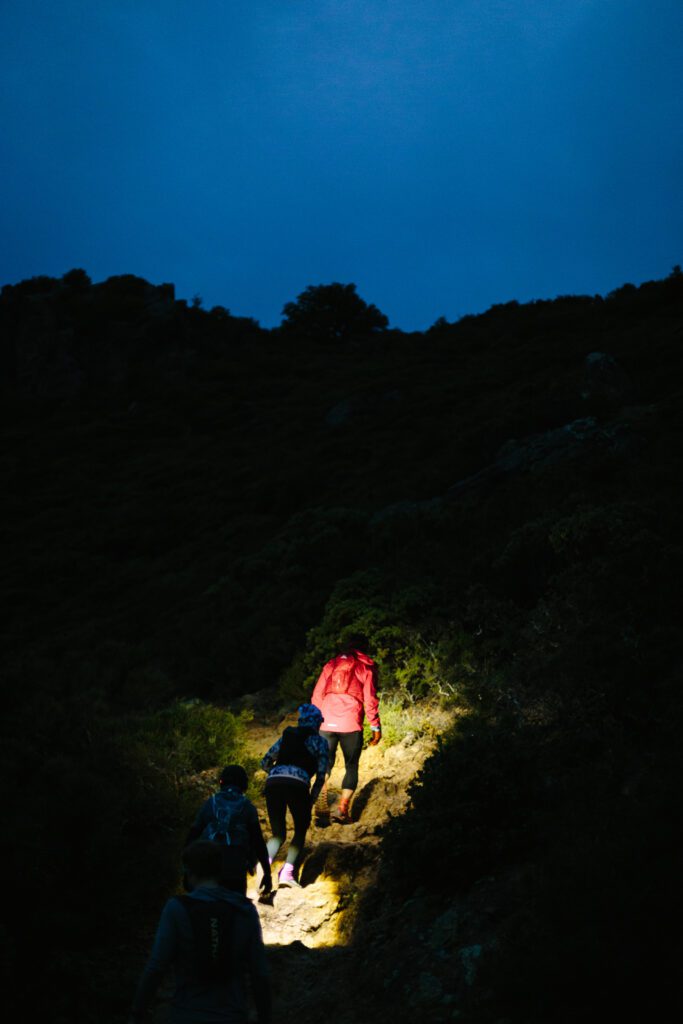
I walk through the municipal garage towards our breakroom, a bland windowless nook converted out of an old storage area. Parked in its spot along a far wall is the Vactor truck. It must have sucked out an environmental sewer this morning. Wastewater is pooling beneath its overflow valve and trickling into the floor drains. The entire garage now smells like shit. I don’t know how the guys in that department do it.
Tearing open a macrobar, I sit down for break and prop my feet on a thick coil of guywire that runs the length of the wall.
“Hey, buddy. Good morning,” begins Michael’s latest voice memo. “It’s 7:17, day eight. Heading out for lap one. We’re on summit twenty-four. Feeling good. Slow start.”
He sounds weary. It’s obvious he’s tired.
“I think I have concluded that we’re going to do three laps a day. Very manageable. This late in the game, four laps would have to be a really good day. It might come at too much a cost. And so, slow and steady.”
I see mist through the trees. A dim emerald pallor glimmers faintly in the space between branches.
“Today is Thursday, that will put us at lap thirty-nine by end of day Monday. Then we will queue out Tuesday, last run beginning at 9am.”
I brush against lichen on the boulders. I watch it flake off and fall like snow.
“Two guys will run up with me. Kendall, who hasn’t been able to run, I want him to go up and meet me for the final door tap with the rest of the crew so we can get a photo.”
I smell eggs cooking, broth coming to a boil, and all the spices of distant markets. I hear kitchen clatter. A radio playing soft. Whispered conversation. I see Kendall placing a bowl of noodles on the table. Kendall taking a roller to Michael’s calves. Kendall asleep on a blow-up mattress.
“Then we’ll meet back at the bottom, and we’ll take all of the lap numbers that we’ve been posting on the fence and stick them to clock.”
I see Kendall charge the smartwatches. Kendall draw a bath. Kendall divvy out salt tablets and naproxen. I see Kendall give and give and give and give and give.
“I’ll come down with the last number and hand it off to Kendall. He doesn’t know this.”
I see Kendall and Michael sharing a quiet moment on the porch.
“He is going to want me to stick the last one up, but I’m going to let him.”
I see Kendall and Michael embrace beneath the clock.
“It’s only appropriate he gets to tag the last one.”
I see a friendship capable of conquering mountains.
* * *
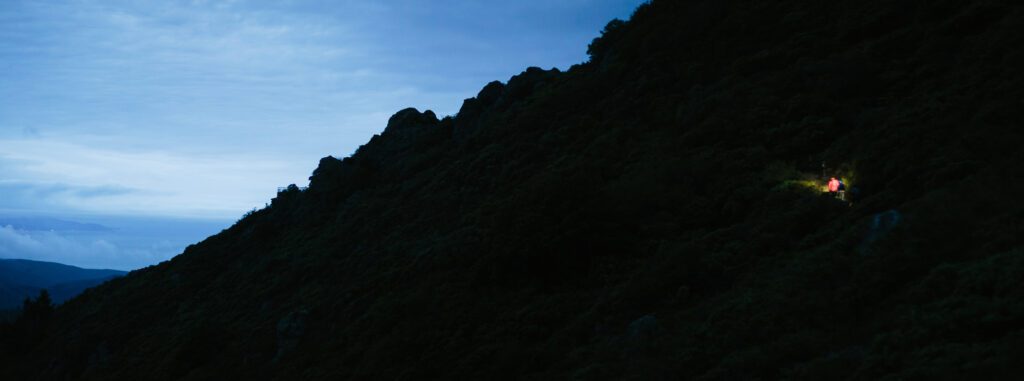
God, I wish you could see this.
Michael removes a flask from his vest and squeezes out a drink of water. A lone bead dribbles down his chin. He mindlessly wipes it away with the back of his hand. “This is my favorite spot on the mountain,” he says.
We stand on an exposed outcropping of rock, three-quarters of the way up Mt. Tam, facing south toward the bay. A cool, muted gloss of soft silver lighting dampens the sky, blackening faraway peaks, and bathing everything else in a slick mercurial sheen. The ocean is cerulean and featureless. Distant buildings stand out in cobalt variations, their fading light glinting with all the luster of diminished aluminum. Heavy, low-slung clouds charge across the sky like an armada of steel-grey warships. Everything looks like it was hammered out of gunmetal.
And it’s fucking beautiful.
At the end of the day, it is still my journey.
The faint musk of the early morning drizzle has blended with the dense piney essence of Douglas-fir and given the breeze an aroma of fecundity. It feels like every pore on earth is waking up to drink this in. And all I hear are our own tiny frictions. The whisper of fabric. A lens closing rapidly. Pebbles crushed beneath new weight.
“It looks like it has a pulse,” Carla says of the city below.
And she’s right, it does. I look past the valley and across the bay, and it begins to feel like those far off lights are pounding out a message, imploring me to pay attention, to soak this in, to wrap myself in this slate grey dawn and understand it for what it is—Michael’s gift to me.
This is my Mt. Tam sunrise.
Those raw emotions and vulnerabilities that I feel, that openness of heart that feels everything around me, that is something that I rarely feel.
I look over at him and he is smiling at me.
I want more of that.
I smile back.
I am going to lean in hard to that dark unknown and see what else is on the other side.
Thank you, Michael.
From the bottom of my heart, brother—Thank You.
* * *
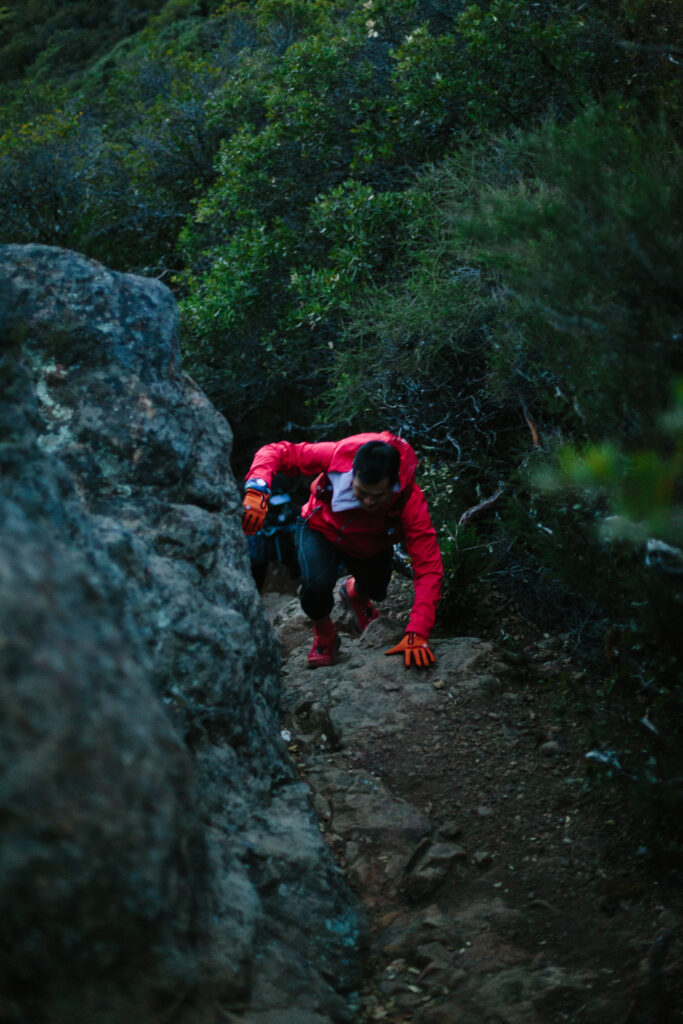
In the end, he ran 320 miles, with 102,880 feet of vert, over thirteen days.
“Call this what it is, religious or whatever, but this was an epiphany,” says Michael. “Maybe it’s the Universe, or a greater plan, I don’t know, but so many pieces lined themselves up and came together. Reflecting back, I didn’t really plan for a lot of this. Things just fell into place.” He laughs. “I am sounding like a Buddhist, seeing all these universal signs.”
Early on, Michael had chosen to amend his approach, stepping back from his initial goal of four laps per day. “It turned that three laps was the most optimal,” he says. “On the fifth day, when I did four laps, it nearly broke me. We came in at 12:30am. I was super tired. I was low on energy and fading. I sat down at the kitchen table. It wasn’t like I didn’t want to do this anymore, but my body had the wind knocked out of it and I needed something.” Michael found his answer in a bowl of bone broth. “I drank it and literally the life came back into me.”
“That was the only low moment I had physically.”
With his plan moderately scaled back, Michael leaned on his crew for motivation and support. Bruce Nguyen. Satpal Dalal. Norman La. Cindy Young. And, of course, Kendall. Every one of them stepped up on his behalf and helped usher him home. “They have families. They have kids. They have school pickup,” says Michael. “One would come one night, another the following night. They would alternate. They would finish the last lap with me, drive home for the night, and be back the following morning to do another lap. Sometimes they stayed, but there were nights they only got a couple of hours of sleep. Having those people in my corner gave me a way to relax like I have never felt before.”
“I let go,” says Michael.
“I used to be a type-A planner. Very rigid. I’m more receptive now. The more at ease I feel, the more I lean into the unknown. One of the biggest takeaways from all this has been that the scariest part was also the most amazing part. The more I let go, the more okay I became with the unknown. It’s not as scary as I thought it would be.”
In the days and weeks that followed, Michael found himself repeatedly feeling overwhelmed by the outpouring of support from the ultra-community, most notably from those who had signed up to join him on the mountain. “For thirty-nine laps, I had company,” he says. “Apart from the fifth lap, on the second day, I was never alone.”
When Michael reflects on this, he gets emotional.
“It was a glorious sunrise on that second morning,” he says. “And I cried. Tears just came out of me. It felt very cleansing. I left something behind and come down a different person. I shed a layer. Whatever that moment of sadness meant, I left it behind.”
“The mountain healed me.”
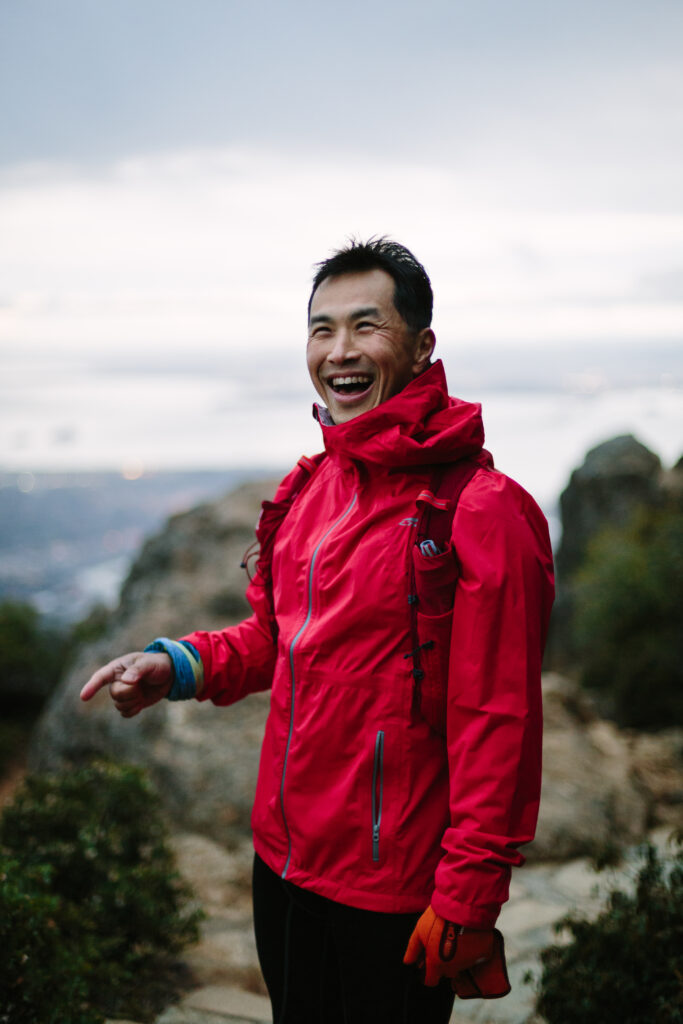
I am seated on an aisle in the tail section of a Boeing 737.
We should be airborne somewhere over western Iowa. Instead, we’re grounded in Chicago. There are technical issues in the cockpit. Problems with a gas gauge. That’s all we’ve been told.
Our inertness feels heavy and ripe.
The old man next to me is all elbows. He claims both armrests with startling aggression. Thick black frames make his eyes look far away even in his own head. Grey haired and jowly, he tucks his blue paper mask beneath his bulbous, finely pocked nose only to—seconds later—slide it back up over his hooked bridge. Then he does it again, pulling the mask under his nose. And again, it goes back up. And again. And again. Fine dry sprigs of brittle hair dangle from each of his nostrils like desert vegetation. I am certain this delay is all his fault. This fucker shorted out the gas gauge.
WhatsApp vibrates my phone. It’s Michael. I want to lash out at the man next to me. Expose him as a saboteur. Yell at him to go fix the fucking gauge. Until we taxi, he is the source of this delay. The target of my misguided frustration. The reason I am not yet en route to California.
To Mt. Tam.
To Michael.
This quiet old man in black sweatpants, reading a book about birds.
I need to let go and exist vicariously through the message.
“Hey, good morning, buddy. It’s Michael Li here.”
There is an emptiness to the space around him. I hear no birds, no airplanes, no traffic noise of any kind.
“It’s 8:29am. I started a little late this morning. I took an extra hour to take care of some necessary housekeeping, but I also took the time to get a little sleep.”
I try to picture the mountain. I try to picture the ocean. I try to picture what Michael looks like in person.
“I was in a deficit the last couple of nights, only getting four hours of sleep. So I slept in for an extra hour knowing that its only day two and I didn’t want to get too far in the hole.”
Everything I see is generic. Generic mountains. A generic ocean. A generic Michael.
“And that was helpful. I took a little longer to have cup of coffee and connect with people who are being so supportive. I am up here…”
Michael’s voice cracks.
“…at about mile three, almost to the top.”
He sobs.
“God, I wish you could see this.”
Me too, man. Me too.
“You will.”